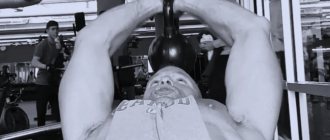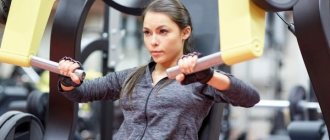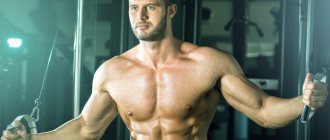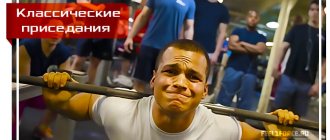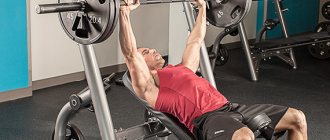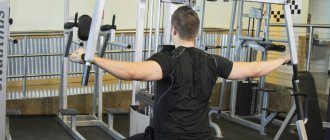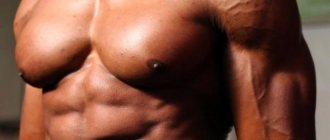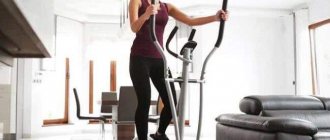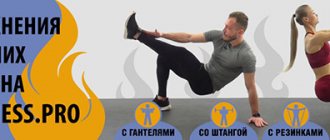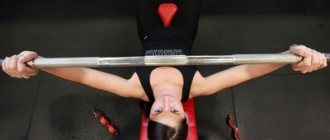Author: Timko Ilya - the ruler of the entire site and fitness trainer | more details >> Rod. 1984 Trained since 1999 Trained since 2007. Author and creator of the site tvoytrener.com. CCM in powerlifting. Champion of Russia and South Russia according to AWPC. Champion of the Krasnodar region according to IPF. 1st category in weightlifting. 2-time winner of the Krasnodar Territory championship in t/a. Author of more than 700 articles on fitness and amateur athletics. Author and co-author of 5 books.
Place in the ranking of authors:
out of competition
(become an author)
Date:
2012-05-29
Views:
801 104
Rating:
5.0
| All articles by the author >> | Medals articles >> |
Articles are loading...
| Article medals: | article in TOP 100 | more than 500 thousand views |
Why medals are given to articles:
| Bronze medal: | |
| 1. The article is in the TOP 100 2. The article has more than 3. The article has more than 100 | |
| Silver medal: | |
| 1. The article is in the TOP 50 2. The article has more than 3. The article has more than 500 | |
| Gold medal: | |
| 1. The article is in the TOP 10 2. The article has more than 1 3. The article has more than 1,000 | |
Main muscles - pectoralis major Additional - anterior delta and triceps Difficulty - medium
What muscles are involved?
Let us immediately note that the main muscles involved are the pectoralis major and minor. These groups are the focus when working with block weight simulators. Hummers are the most popular, but there are other proven mechanisms. In addition to breasts, you can develop:
- shoulders (back, middle, front deltas);
- lateral triceps bundles;
- medium and long triceps bundles;
- serratus anterior abdominal muscle.
Important! The exercise is considered isolated and allows you to work out the pectoral muscles as much as possible. This should be taken into account when building your training program.
Seated press and Smith machine
Seated barbell press in a Smith machine is an exercise for the shoulders and upper chest. Let's look at both options.
Seated Angle Press
Place an incline bench under the bar of a Smith machine. Position it so that when you lie down on the bench, the bar is level with the middle of your pecs. Set the back angle to 45 degrees. This position is also called “sitting”. There is no need to hang anything yet; initially the bar weighs 20–25 kg, which is just right for warming up.
- Sit on a bench, press the top of your buttocks to the bottom of your back. Bend your lower back forward, squeeze your shoulder blades together, straighten your shoulders. Press the back of your head against the back of the bench.
- Grasp the bar with a wide grip (palms wider than shoulder width). Usually there are risks on the fingerboard that you should follow. You can do this: find the marks located closer to the edges of the fingerboard and place your ring or middle fingers on them. This makes it easier to achieve a symmetrical grip. By the way, the grip is straight.
- Remove the bar by twisting it to remove the clamps.
- Gently lower it onto your chest. The bar should be located between the shoulders and the pectoral muscle. This is the correct position. Lower it as far as possible, stretching the front deltoids and pectoral muscles.
- Lift up as you exhale, repeat 10–15 times. The warm-up is over.
Now set the desired weights and do 8-10 repetitions in 3-4 sets. If you can't squeeze out the last reps, rotate the bar in a critical position: it will lock. Or ask a friend (coach) to back you up.
There is a nuance - for some it is convenient to turn the bar away from you, for others - towards you. Experiment with how it is more convenient for you to do this. Because at the critical moment, when you need to fix the barbell, you may not succeed. That is, if turning in one direction is inconvenient for you, turn the bench 180 degrees.
Seated Vertical Press
In this case, the bench press in the simulator is an imitation of a barbell bench press while sitting on the shoulders. You need to install an inclined bench under the bar, which should be strictly above the seat (preferably in the middle). Adjust the height of the bar so that when sitting, it is level with the top of your head.
We will be lowering the barbell behind our heads, so make sure the bench position allows this to happen.
- Grab the bar with an overhand grip and lift it up. The grip is slightly wider than the shoulders, be guided by the marks on the bar (they are located exactly where they are on the free bar).
- Don't forget that this is a warm-up. This option is not suitable for girls, the weight is too heavy, it is better to rock your shoulders in a different way. Therefore, we recommend the Smith press for men. Raise and lower the empty bar 10-15 times. The warm-up is over.
We hang the pancakes, perform 3-4 approaches in 8-10 repetitions.
Exercise technique
Make sure that the handles of the machine are adjusted to the level of your shoulders (or slightly lower). Sit up straight, press your back and neck against the back of the machine. The legs should be spread wider than the shoulders, and the feet and knees form a right angle. Use an overhand grip with your palms facing forward. Hands - approximately shoulder width apart. Procedure :
- Take a deep breath and begin to squeeze the handle away from you, trying not to exhale.
- You can exhale in one of two cases - when you have passed the point of highest tension or with your arms fully extended.
- The top point is the right moment for a short pause.
- Hold your breath.
- Proceed to smoothly, without jerking, return the handles to their original position.
- At the lowest point of the amplitude, do not take any breaks - immediately squeeze the handles according to the scheme described above.
On a note! The exercise differs in that each arm of the athlete receives a personal load. This leads to uniform pumping of muscle groups. You can get a similar effect by working with dumbbells. It’s just not recommended to change the amplitude in the simulator.
Recommendations for performing the exercise effectively
Seated presses are the ideal finishing movement for an upper body workout day. It is advisable to include it in the lesson plan after basic exercises on the chest and shoulders and perform it in a multi-repetition mode: this way the target muscles will receive high-quality development. This is especially true for experienced athletes who have already built up muscle mass. In addition, here you can work to failure without fear of being crushed by the barbell.
The design of such simulators allows you to do presses with one and the other hand alternately. This may be relevant if there is pronounced muscle asymmetry and correction of the load is required in relation to one of the arms.
Presses in simulators allow you to change the emphasis by changing the grip. For example, when training the pectoral muscles, a wide grip more actively engages its outer area, while a narrower grip activates the inner part of the pectorals and triceps.
If an athlete has an injured shoulder joint, it is not recommended for him to do a full-amplitude bench press: in the lower position, the elbows should not extend beyond the plane of the body. In such situations, it is advisable to train in devices with a special lever for applying weight.
Seated presses in simulators will complement the training program for the development of the upper body: performed in combination with basic exercises, they will significantly increase the effectiveness of the training. Pressing movements in special devices can become the basis of a training program if the athlete does not plan to gain muscle mass or is recovering from a shoulder girdle injury.
Are there any alternatives?
It is important to understand that we are talking about the “finishing” type of strength exercises. The seated press is performed at the end of the workout to focus attention on poorly developed muscle groups. The bench press is more popular, but it is not suitable for bodybuilders who have suffered a back injury. Thus, the bench press and seated press are interchangeable, but it all depends on the presence/absence of injuries. You can also achieve a similar effect by pressing dumbbells.
This is not a basic exercise. The seated press in the machine is an imitation. You lift the usual pancakes, only they are secured in blocks. This exercise will not seriously increase muscle mass, but you will get the desired relief.
Avoiding mistakes
To ensure that the exercise brings maximum benefit and does not negatively affect your health, follow the following recommendations:
- When pressing, do not bring your shoulders forward. While sitting in the exercise machine, you keep your back pressed and your shoulder blades retracted all the time.
- Spread your elbows out to the sides. They should not stick to the body, as during triceps exercises.
- Try to perform the movement as efficiently as possible and without jerking. First comes the development of the technique, then the increase in load. This is a universal rule.
- In the initial position, the pectoral muscles should stretch as much as possible, and in the extreme position, contract. Pay attention to mental control. When you become aware of how your muscles are working during a movement, it makes your workouts much more effective.
Performing bench presses on a lever machine allows you to perfectly polish your muscles. It is recommended to use this exercise to complete chest training, as a final chord. It also helps overcome muscle asymmetry, which sometimes occurs.
Good luck to you and outstanding sporting results!
Let's consider the benefits
So, why not dumbbells or a “standing” version? The exercise has a number of advantages that allow you to confidently introduce the seated press into your training complex. These are the advantages :
- Effectively working the pectoral muscles with minimal stress on the back.
- Platen racks are useful when dealing with injuries.
- The isolating type allows you to maximally work specific muscle bundles.
- The technique is quite simple.
- The risk of injury is reduced to a minimum.
- The trajectory of movement of the handles is rigidly fixed.
The best exercise machines for the pectoral muscles in the gym + technique
The number of exercise machines for the chest muscles is not as large as for other groups. But by using different techniques, as well as a combination of basic exercises with free weights and focused machine work, you can ensure maximum development of the entire area.
Hammer press
This chest exercise on a machine is considered not just a replacement for the incline barbell press, but a full-fledged variation that must be included in the training plan. Its main advantage is that when performing the movement, the stabilizer muscles are almost not involved in the work. The main load goes to the pectoral muscles. Basically, the hummer simulator is designed for pumping the upper part of the pecs (arms move at an angle), although there are versions with the ability to adjust the trajectory of movement.
Technical advice from professionals
It is important to take into account the following detail : mainly the anterior muscle bundle is worked out. The triceps is involved as an extensor, the serratus anterior and pectoralis minor muscles are responsible for shifting the shoulder blades. Fitness trainers recommend paying attention to the following details:
- the maximum load is obtained only in one case - when the elbows move along the trajectory of a small arc;
- Having reached the end point of the amplitude, do not forget to move your hands in the direction of the conditional center of the body;
- the shoulder blades should move to the sides when performing the exercise;
- contractions of two muscle bundles - the serratus anterior and pectoralis minor - will help make the body static;
- try to turn off the stabilizer muscles - this is how you can work the target group;
- Do not move your elbows too far behind your back;
- Make sure that the pectoral muscles do not relax at all.
A guarantee of no injuries is to hold your breath at the start. The spine is extended, which leads to an anatomically correct location of the joints. According to statistics, strength increases by 20% with breathing holds.
“To increase the intensity, I do a full stretch—lowering the weight as much as possible. The arms at the elbows should straighten completely, and at the final point of the amplitude I rest for no more than a second. Partial reps at the end of a set are another secret to my success.” (Dorian Yates)
Tips for maximum efficiency
- Before starting your workout, do a set of warm-up exercises. Focus on your shoulders and pectoral muscles.
- If you experience discomfort in your shoulder and elbow joints while doing a bench press, it means you have not adjusted the height of the machine correctly.
- When working with heavy weights, use the help of a training partner. It will help move the handles from the starting position to the starting position. Some block exercise machines have a special pedal installed for this purpose.
- To protect your wrists, you can use wrist wraps.
- Do not lift your legs while performing the exercise. This will cause the torso to twist and may cause spinal injury.
- The exercise should be performed in the average range from 12 to 15 times. Provided that the last two repetitions will be difficult for you.
- Be sure to perform at least 1 warm-up set with light weight.
As you can see, the exercise requires special attention to execution technique. Yes, working in a machine is safer than working with free weights. But this does not mean that you can do whatever you want. Therefore, be sure to warm up before training, work on your technique and avoid mistakes. And then your results will constantly improve.
Typical beginner mistakes
Let's look at the typical mistakes of novice bodybuilders when doing chest presses in block weight machines. Most of the “jambs” have already been voiced, so let’s summarize :
- elbows pushed too far back;
- improper breathing;
- pauses between repetitions;
- sudden jerks;
- pushing out the weight with the body (this should be done with the pectoral muscles);
- incorrect height adjustment of handles;
- legs brought together or straightened at the knees.
Advantages and contraindications
A leg press machine can be found in any sports club or fitness center. It is equally effective in increasing muscle mass and during the drying period, drawing relief. The bench press takes second place (the first place is held by squats with a barbell) among exercises for developing strong legs and beautiful lower relief.
Women should understand which muscles work when performing exercises in the simulator. The work involves the buttocks, hamstrings, quadriceps, calf and soleus muscles.
Using the exercise, you can quickly work out the lower muscles, avoiding the load on the thoracic and cervical spine. Proper bench press is characterized by a number of other advantages, among which are:
- fat burning effect;
- relieving stress from the knees and lower back;
- the ability to shift the focus to the buttocks, back, front or side of the thigh.
As for the shortcomings, there are practically none. A significant disadvantage is the high risk of injury of the exercise. If you know how to do it and follow safety precautions, the risks of getting damaged or injured are reduced to zero. Don’t try to set a record and immediately take heavy weights, for example, 300 kg and perform 3-5 repetitions. It is better to set 150 kg and perform 3 sets of 10-12 times.
Before mastering the exercise, you should study the contraindications for exercise. People with joint injuries and sprains, lumbar hernia and other curvatures of the spinal column (kyphosis, lordosis, scoliosis) should avoid training.
Bench press VS seated press: the agony of choice
Probably, many athletes were tormented by the torment of choosing between two types of chest press - sitting and lying. The question comes down to this: Can you lift the same amount of weight doing a seated chest press as you can doing a bench press? The answer is: sitting, you live more. But don't rush to conclusions. The bench press has its advantages and disadvantages. Let's start with the pros:
- Synchronized hand movement.
- Increased strength as you lift heavier weights.
- Working with free weights, which leads to activation of stabilizer muscles.
Among the disadvantages, we note the dangerous position of the shoulder joints, the high level of injury risk with incorrect technique and the need to constantly search for a partner for backup. The simulator successfully solves these problems. Meanwhile, the bench press remains the foundational powerlifting exercise and produces maximum muscle growth. And the seated press pumps certain bundles, that is, it carries an additional load, and not the main one.
The free weight bench press is a more accurate measure of your strength compared to a machine. Since the weight of the barbell with weights can vary significantly from the weight of the loads in the simulator.
Summarize . You shouldn’t give up the barbell in favor of a block weight machine. With the guidance of a good trainer, you will eliminate the possibility of injury under the barbell while lying down and quickly build muscle mass. And exercise machines like the Hummer will help strengthen individual bundles. Combine these exercises in a general program - and you will be happy.
Features of the exercise
The machine chest press, unlike the bench press, is considered an isolation exercise. Leaning your back on the bench, you push two independent handles in front of you. The amplitude of movement of these handles is clearly defined. Because of this feature of the simulator, movement occurs only in the elbow joint. As for the distribution of the load, it is concentrated as much as possible on the chest muscles. The stabilizer muscles, which are actively involved in the work when performing bench presses with free weights, are practically not involved in this case.
Chest press in a sitting machine in an inclined position.
The chest press on the lever machine is used to finish off the pecs after performing basic exercises.
Benefits of bench press:
- Accented load on the pectoral muscles, minimizing the work of the stabilizer muscles.
- The ability to work separately on the right and left sides of the chest, thanks to the independence of the handles of the simulator from each other. This can be useful if there is some muscle asymmetry.
- Safety of the exercise in terms of the likelihood of injury. As long as you follow the technique and avoid exorbitant weights (which in principle are not used in this exercise).
However, the same lever design of the simulator, in addition to its advantages, also gives rise to some disadvantages:
- There is no way to perfectly fit the simulator to suit you. You can only change the seat height. The inclination of the arms in relation to the body is rigidly specified. Since all people have different body proportions, it is not always possible to sit comfortably in the exercise machine.
- From the previous point it follows that it is impossible to use large weights in the exercise. To produce maximum results with significant weights, you need to take an absolutely comfortable and natural position. However, based on the purpose of this exercise (finishing), large weights are not needed here in principle. Therefore, this disadvantage can be considered conditional.
Hummer Seated Press
The hammer simulates a barbell or dumbbell press at different angles, usually 45 and 60 degrees. This machine will help you pump up your upper chest and front deltoids.
It has a device (pedal) for bringing the weight to the starting position. Use light weights for warming up.
- Adjust the seat height so that in the initial position the handles of the hummer are at the level of your shoulders, and your arms do not “twist” back. If the seat is too low, your elbows will be extremely far back. It is very difficult to start a repetition from such a position.
- Help lift the weight with your foot by pressing the special pedal.
- After the handles have returned to the starting position, squeeze them out with your hands (you don’t have to straighten your arms completely so that the elbow joints don’t snap into place - leave a slight angle between the forearm and shoulder).
- Lower the weight back to a physiologically comfortable position. Repeat this movement 10-15 times – the warm-up is complete. As you climb, don’t forget to exhale through your mouth. Inhale through your nose while lowering the weight.
- Help lower the weight to its original position using a special pedal.
Set the working weight and do 8-10 repetitions in 3-4 sets.
Shoulder exercises
Basic shoulder exercises are performed with free weights or machines.
The barbell is most effective for pushing the maximum with a heavy load.
Dumbbells require more coordination, but will help avoid imbalances in shoulder muscle development.
Training the deltoid muscles involves multi-joint exercises. Avoid isolation exercises for the anterior and middle bands, as these groups receive enough load from basic training.
Standing barbell press
The standing barbell chest press is the most effective way to develop the shoulders because it focuses on the anterior head of the deltoid while also engaging the middle and part of the posterior deltoids.
The elbows brought forward emphasize the exercise on the front beam, the elbows spread to the sides use the middle deltoids more.
It is allowed to use dumbbells instead of a barbell and do bench presses alternately.
- Stand shoulder width apart. Raise the barbell to your chest, keeping your back straight.
- Squeeze the barbell upward with one push, without tilting your body.
- Lower the barbell slowly to your chest.
Military press sitting or standing
Performing a standing military press is much more difficult than a sitting one, since the shoulder muscles are activated a little more in an upright position.
The standing press puts much more stress on the lower back and core. This means you won't be able to lift your maximum weight and have a higher risk of injury. If you want to put maximum stress on your shoulders, then the seated military press technique allows you to work your shoulder muscles with heavier weights. This exercise involves the front and middle deltoids.
- Place the barbell in a power rack or squat rack before beginning the exercise. Make an overhand grip slightly wider than shoulder width.
- The initial position of the bar is at the level of the upper chest and shoulders. Press the barbell up while inhaling and moving your elbows out to the sides.
- As you exhale, return the bar to its original position to complete the exercise. Don't touch the barbell to your chest or use your legs for this exercise, otherwise you'll end up with a push-and-press movement that only needs to work your shoulders.
Raising dumbbells in front of you
This exercise is for effectively developing the anterior deltoid; the middle fascicle is also partially involved.
You can use an overhand grip on the dumbbells or turn your palms towards each other - this neutral grip will increase the load on the target muscles.
- Stand straight, holding dumbbells in front of your hips, with your elbows slightly bent.
- As you inhale, raise your arms using force in the shoulder joint. Maintain a constant distance between your hands.
- At the top point, when your arms are parallel to the floor or slightly higher, exhale and slowly lower your arms.
To isolate the deltoid muscle, lifting dumbbells in front of you can be done while lying on a bench inclined at 45 degrees. Choose a comfortable position so that your hips do not interfere with the movement of the dumbbells.
Standing dumbbell raises
To form beautiful three-dimensional shoulders, you need to train the rear deltoid - this is the smallest and weakest of the shoulder muscles.
For detailed work, use an isolating exercise such as dumbbell lateral raises.
- Start in a standing position with dumbbells hanging at your sides.
- Raise your arms to the side until they are parallel to the floor while exhaling. Bend your elbows slightly and turn your hands out as if you were pouring a drink from a glass. Stay in this position.
- Inhale slowly and lower your arms back to the starting position. Maintain a slight bend in your elbow throughout the exercise.
Bent-over dumbbell raises
To develop the rear delt, an exercise similar to standard lateral raises is suitable, except that the body should be tilted forward.
The procedure is performed standing or sitting, bending to the knees. For stability, you can rest your forehead against the back of the bench. Use light weight and precise technique.
- Get into a standing or sitting position with a dumbbell in each hand. Keep your chest lifted and your back flat. If you are doing the exercise while seated, bend over your knees until your forehead almost touches the bench. If standing, bend at the hips and keep your chest parallel to the floor. Dumbbells hang under your chest, elbows slightly bent, palms facing each other.
- Raise the dumbbells up so that your upper arms are parallel to the floor. Positioning your elbows higher than your back will put more stress on your deltoids. Make sure that the arches created by hands are symmetrical.
- Hold the weight for a moment at the top of the arc and slowly lower it to the sides.
- Begin the next repetition immediately before your arms reach a position perpendicular to the floor.
Flying dumbbells back while lying on your stomach on a bench will relieve excess stress on the lower back, but this position will block the chest, which may be uncomfortable.
Barbell row to the chin
This is a basic exercise for working out the middle beam. Watch the location of your elbows; they should be in the plane of your body.
An overly narrow grip redistributes the load on the front deltoid and changes the amplitude of movement; you can use a grip similar to a military press.
- Using an overhand grip, grab the barbell slightly narrower than shoulder-width apart. The bar is on the hips, the shoulders are straightened, there is a normal deflection in the lower back.
- As you inhale, pull the bar up and spread your elbows to the sides. The bar moves in a vertical plane, maintain a level body position.
- The elbows at the top point are higher than the shoulders. Hold as you exhale and slowly lower the bar down.
Shoulder training equipment
Many shoulder exercises with free weights can be replaced with a suitable machine. For example, a seated military press can be conveniently performed in a Smith machine using a bench at an incline of about 80 degrees. Arm raises can be done in a pulley machine while pulling the lower block.
The dumbbell press is replaced by performing exercises with harnesses in a crossover. However, in this case, the elbows cannot be raised above the shoulder line, and you will have to work one arm at a time. This exercise can also be performed while sitting in a machine - this eliminates the risk of lower back injury.
The barbell row to the chin is replaced by an exercise in the Smith machine, while the row is done with one hand. This simulates a wide grip, which is inconvenient to perform directly in an exercise with a barbell.
Exercise options
- The main option is a bench press with a wide grip. The hands are directed forward. Read the detailed description at the beginning of the article.
- Shoulder press with a narrow grip. The hands are turned opposite each other.
- Seated press facing the machine.
- Alternate shoulder press in the simulator.
Close-grip seated machine press
Close-grip seated machine press
The maximum load falls on the anterior deltoids of the shoulders. The upper bundles of the pectoral muscles are also connected.
Seated shoulder press facing the machine
Seated shoulder press facing the machine
All shoulder bundles work. Anterior, middle and posterior deltoids. The exercise requires good flexibility and significant training experience. Perform it once you have mastered the basic movement - the shoulder press.
Alternate shoulder press in the simulator
Alternate shoulder press in the simulator
Helps to better work out the muscles of the shoulder deltas individually.
Common mistakes
- Full arm extension. In the starting position - the top point of the movement, always keep your arms slightly bent.
- Large range of motion. Avoid performing full range of motion exercises with heavy weights. Wear on the joints increases, which gradually leads to injury. Lower your hands to the level of the tops of your ears, maximum to the level of your chin.
- Bringing your elbows back. Lower your elbows down, keep your forearms vertical.
- Lifting your back off the bench. Place your back and pelvis tightly and hold them on the machine bench.
- Sudden movements and improper breathing. Perform smooth movements, lifting twice as fast as lowering. When lifting, exhale; when lowering the weight, exhale.
Recommendations for seated shoulder presses
- The exercise works well on the movement of the press upward along a given amplitude. Having strengthened the muscles at the beginning of training (2-3 months of training), you should try to perform an exercise with dumbbells to practice coordination of movement and stabilize the shoulder muscles and shoulder rotators.
- To comfortably lift the weight of the machine to its original position, use a special leg lever . The lever is not always provided by all manufacturers of exercise machines. In this case, use the help of training partners or gym instructors.
- For greater isolation of the shoulder muscles, do not lift the weight to its highest position. Work with a short amplitude to reduce the use of your triceps.
- Concentrate on your shoulder muscles. When you think about muscles while performing movements, muscle fibers are worked 20-30% more efficiently.
Special lever for the shoulder press machine
Did you like the article? Subscribe to us on social networks and be the first to know about new products!
Shoulder press in the machine. What, why and why?
When it comes to the gym, women, for the most part, are big fighters. They can't shake the feeling that doing free weight exercises like the seated dumbbell press will develop their shoulders to XL size. That's why many ladies pay more attention to exercise equipment... And they do it right. At first, they are the ideal option for strengthening the whole body and a guarantee of mastering the correct technique for performing the movement. Today we will look at one of them - the shoulder press in the simulator.
Note: For better assimilation of the material, all further narration will be divided into subchapters.
Muscle atlas
The exercise belongs to the class of conditionally basic and is aimed at working the shoulders.
The muscle ensemble includes the following units:
- targeted – anterior delta;
- synergists - middle delta, supraspinatus, pectoralis major (clavicular head), triceps, trapezius (middle/bottom), serratus anterior;
- dynamic stabilizers – biceps, triceps (long head);
- stabilizers - trapezius (top), levator scapula.
A complete muscle atlas looks like this:
Advantages
By performing the shoulder press exercise in a machine, you can expect to receive the following benefits:
- increase in muscle mass of the deltas (subject to certain conditions);
- development of the strength of delta bundles;
- strengthening the upper shoulder girdle;
- formation of symmetrical shoulders;
- improved results in the bench press;
- reducing the risk of osteoporosis by increasing bone mineral density;
- Possibility to perform in case of problems with the shoulder joint.
Execution technique
The shoulder press in the simulator is an exercise of entry-level complexity. The step-by-step execution technique is as follows:
Step #0.
Go to the machine and set the working weight. Sit in a “chair”, spread your legs to the sides, place your feet firmly on the floor, and grab the handles of the exercise machine with your hands. Statically tighten your abs, direct your gaze forward. This is your starting position.
Step #1.
Inhale and as you exhale, straighten your elbow joint and press your arms up. At the top point of the trajectory, hold for 1-2 counts and slowly return your hands to the IP position. Repeat the specified number of times.
In picture form, all this disgrace looks like this:
In addition to the standard version of the shoulder press in the simulator, there are several variations of the exercise:
- neutral grip bench press;
- bench press while facing the bench.
Secrets and subtleties
To get the most out of the exercise, follow these guidelines:
- use a grip slightly wider than shoulder width;
- when taking the handles of the simulator in your hands, adjust the height of the seat until your hands are positioned just above shoulder level;
- slowly and controlledly lower the weight down and powerfully, explosively lift it up;
- use full range of motion;
- do not fully extend the elbow joint at the top point;
- throughout the entire movement, keep your head, back and buttocks in constant contact with the “chair”, and your legs motionless on the floor;
- do not lower the weight/handles of the machine too low, below shoulder level;
- breathing technique: exhale - when squeezing the frame upward, inhale - when returning to the PI;
- numerical training parameters: number of approaches/repetitions – 3x10-12.
We're done with the theoretical side, now let's look at some practical points.
Is the machine shoulder press a good exercise for deltoids?
Electrical activity data (Exercise Physiology Laboratory, USA 2015 ) for shoulder exercises (EMG for the anterior deltoid) show the following:
- seated dumbbell press – 83;
- seated bench press - 81;
- seated dumbbell raises – 75;
- standing raises with dumbbells – 72.
Thus, the seated shoulder press is a very effective exercise for developing the anterior and middle (to a lesser extent) deltoids.
How to pump up a girl's shoulders using exercise machines?
Decorating hangers is exactly what the girls want for this muscle group. By “design” we mean their chiseled silhouette and relief. Here is a PT for solving this problem:
- duration: 10 weeks;
- number of training sessions per week: 2 , Monday/Friday;
- exercises: superset: seated head press in a Smith machine + shoulder press in a neutral grip machine; raising arms to the sides while sitting in a machine with rollers + reverse butterfly in a machine;
- number of sets/repetitions: superset No. 1/No. 2: 3x8/3x16.
Use this training program and you are guaranteed chiseled shoulders.
